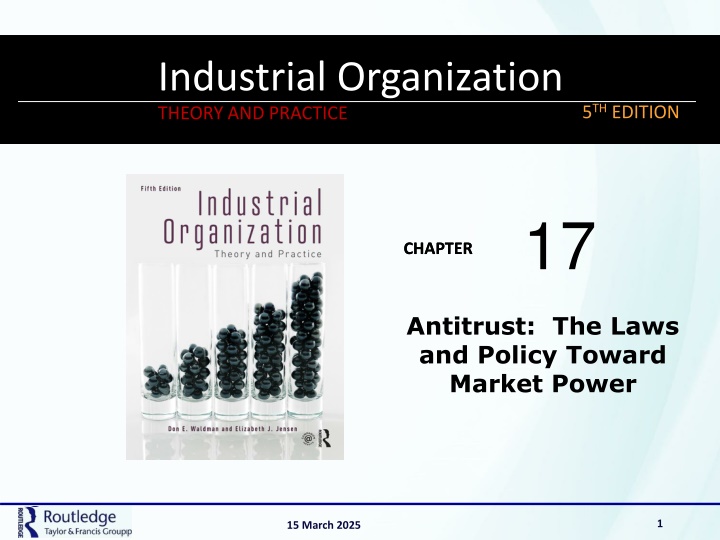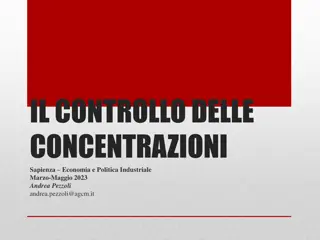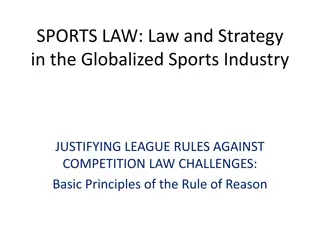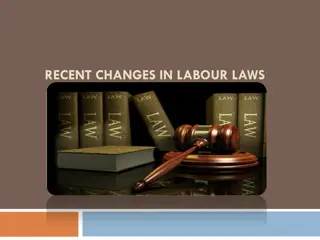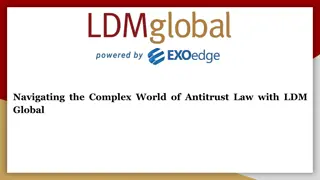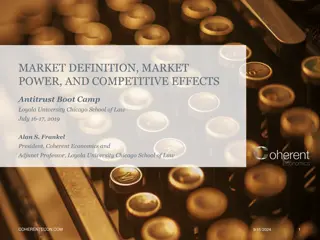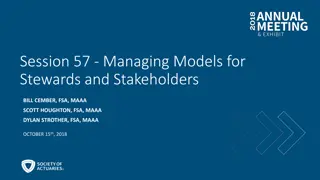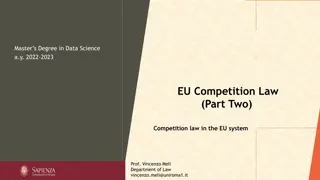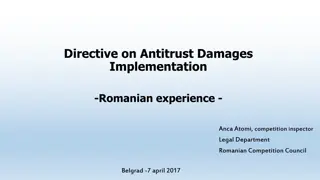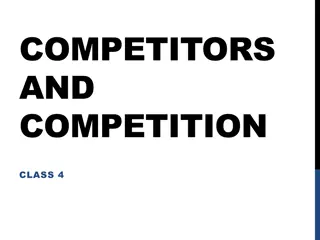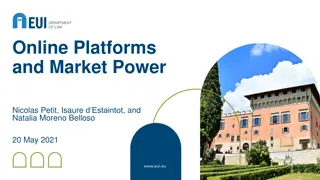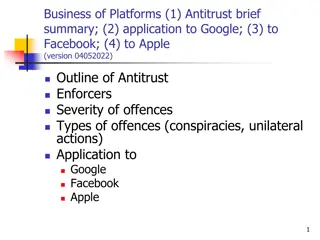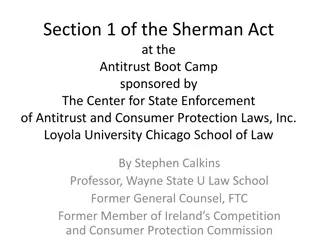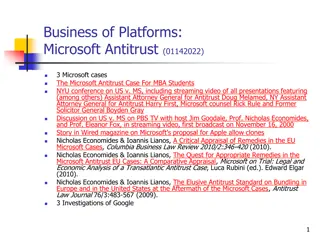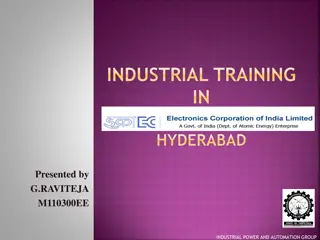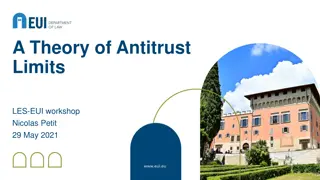Antitrust Laws and Market Power in Industrial Organization
The evolution of antitrust laws in the United States, from the Sherman Antitrust Act of 1890 to the Standard Oil and American Tobacco rulings. Explore the implications of these laws on market power and competition in various industries.
Download Presentation

Please find below an Image/Link to download the presentation.
The content on the website is provided AS IS for your information and personal use only. It may not be sold, licensed, or shared on other websites without obtaining consent from the author.If you encounter any issues during the download, it is possible that the publisher has removed the file from their server.
You are allowed to download the files provided on this website for personal or commercial use, subject to the condition that they are used lawfully. All files are the property of their respective owners.
The content on the website is provided AS IS for your information and personal use only. It may not be sold, licensed, or shared on other websites without obtaining consent from the author.
E N D
Presentation Transcript
MODERN LABOR ECONOMICS THEORY AND PUBLIC POLICY THEORY AND PRACTICE Industrial Organization 12THEDITION 5THEDITION 17 CHAPTER CHAPTER Antitrust: The Laws and Policy Toward Market Power 1 15 March 2025
17.1 The Content of the Antitrust Laws Before the Civil War, the United States was mainly an agrarian society in which high transportation costs kept the geographic size of most industrial markets small. After the Civil War, national markets grew rapidly in many products developed from a combination of 1. mass production, introduced by the industrial revolution, which resulted in significant economies of scale; 2. a national railroad system, which greatly increased the size of the geographic market in many products; 3. the development of modern capital markets that enabled firms to raise large amounts of capital in the equity market; 4. the liberalization of the laws of incorporation in many states. Larger national firms, which took advantage of economies of scale, were often able to invade local markets that were formerly insulated from competition and charge significantly lower prices. During the 1888 national elections, both the Democrats and Republicans offered platform planks to fight the trusts , and immediately before the election Republican Senator John Sherman introduced the first Senate antitrust bill. On July 2, 1890, President Harrison signed the Sherman Antitrust Act in to law. 15 March 2025 2
17.1 The Content of the Antitrust Laws The major provisions of the Sherman Act are sections 1 and 2, which read in part: Section 1: Every contract, combination in the form of a trust or otherwise, or conspiracy, in restraint of trade or commerce among the several states, or with foreign nations, is hereby declared to be illegal. Every person who shall make any such contract or engage in any such combination or conspiracy, shall be deemed guilty of a misdemeanor, and, on conviction thereof, shall be punished by fine not exceeding five thousand dollars, or by imprisonment not exceeding one year, or by both said punishments, in the discretion of the court. ... Section 2: Every person who shall monopolize, or attempt to monopolize, or combine or conspire with any other person or persons to monopolize any part of the trade or commerce among the several States, or with foreign nations, shall be deemed guilty of a misdemeanor.... Section 1 made it illegal for competitors to combine to fix prices and created an incentive for firms to get around the law by merging with competitors. Another major problem developed from the somewhat ambiguous wording of Section 2, which was not effective in dealing with the monopolization problem during the 1890s. In 1911 two major decisions, the Standard Oil and American Tobacco rulings, provided both hope for enforcement and confusion with regard to what constituted a violation of Section 2. 15 March 2025 3
17.1 The Content of the Antitrust Laws In its famous Standard Oil decision, the Supreme Court ruled that only unreasonable attempts to monopolize violated the Sherman Act. This interpretation made only the verb "to monopolize" illegal, while permitting the noun "monopoly" to exist as long as the monopoly did not result from an aggressive attempt to monopolize. This precedent has come to be known as the Rule of Reason. By 1912 there were calls for new legislation. What emerged in 1914 were two pieces of major antitrust legislation, the Clayton Act and the Federal Trade Commission Act. The Clayton Act aimed to prevent certain specific types of business conduct. It contained the following four substantive sections: 1. Section 2 forbad price discrimination "where the effect of such discrimination may be to substantially lessen competition or tend to create a monopoly in any line of commerce." The section provided for three defenses, discrimination based on: the quantity sold; the different costs of selling or transportation; or the need to meet a competitor's lower price. These defenses, particularly the quantity defense, turned out to be large loopholes in Section 2. 2. Section 3 forbad tying contracts, which forced a purchaser to buy Good X in order to obtain Good Y; and exclusive dealing arrangements, which forced a buyer to purchase its entire supply of a commodity from one seller. 15 March 2025 4
17.1 The Content of the Antitrust Laws 3. Section 7 forbad the acquisition of the stock of another corporation if the acquisition would "restrain commerce in any section or community or tend to create a monopoly of any line of commerce." The section was directed at the merger wave that had developed after the passage of the Sherman Act, and was limited to horizontal mergers between direct competitors. Section 8 forbad interlocking directorates between any two competing corporations. This prevented the same individual from sitting on the Boards of Directors of competing companies. 4. The Federal Trade Commission Act established the Federal Trade Commission (FTC) as an independent antitrust agency to enforce the Clayton Act. The FTC Act also contained one major substantive provision, section 5, which reads in part: The commission is hereby empowered and directed to prevent persons partnerships, or corporations, except banks, and common carriers subject to the Acts to regulate commerce, from using unfair methods of competition in commerce. "Unfair methods of competition" could include just about any business practice. Furthermore, many practices considered "unfair" by competitors may have a positive effect on competition. The FTC had little power in its early days and its only available remedy was to issue cease and desist orders. 15 March 2025 5
17.1 The Content of the Antitrust Laws The next major antitrust statute was the Robinson-Patman Act of 1936, which dealt with price discrimination. The Robinson Patman Act amended Section 2 of the Clayton Act to include the following major provisions: Section 2(a): That it shall be unlawful for any person engaged in commerce, in the course of such commerce, either directly or indirectly, to discriminate in price between different purchasers of commodities of like grade and quality, ...where the effect of such discrimination may be substantially to lessen competition or tend to create a monopoly in any line of commerce, or to injure, destroy or prevent competition with any person who either grants or knowingly receives the benefit of such discrimination, or with customers of either of them: PROVIDED, That nothing herein contained shall prevent differentials which make only due allowance for differences in the cost of manufacture, sale, or delivery resulting from the differing methods or quantities in which such commodities are to such purchasers sold or delivered. Section 2(b): PROVIDED, HOWEVER, That nothing herein contained shall prevent a seller rebutting the prima facie case thus made by showing that his lower price or the furnishing of services or facilities to any purchaser or purchasers was made in good faith to meet an equally low price of a competitor, or the services or facilities by a competitor. ... Section 2(f): That it shall be unlawful for any person engaged in commerce, in the course of such commerce, knowingly to induce or receive a discrimination in price which is prohibited by this section. 15 March 2025 6
17.1 The Content of the Antitrust Laws The Robinson Patman Act contained three additional sections that declared specific types of price discrimination illegal per se. An action is illegal per se if there is no acceptable legal justification for undertaking the action. In antitrust law most restraints of trade come under the Rule of Reason interpretation and can be justified by a "reasonableness" defense The sections of the Robinson-Patman Act pertaining to specific types of price discrimination attempted to close potential loopholes in the Act. Section 2(c) forbad the payment of any brokerage commission except for services actually rendered by an independent broker. This section was intended to prevent large grocery chains such as A&P from setting up their own brokerage agencies that would then "charge" their suppliers a brokerage "fee" for the act of transferring goods from A&P to A&P. Section 2(d) forbad a supplier from paying its buyers for promotional services, unless the payments were made available to all buyers on "proportionally equal terms." Section 2(e) forbad the supplier from providing promotional services to any buyer unless the services were made available to all buyers on "proportionally equal terms." The Robinson Patman Act is extremely controversial because it has often been used to protect individual competitors rather than the competitive process. 15 March 2025 7
17.1 The Content of the Antitrust Laws The potential problems are easily seen in a careful reading of Section 2(a), which extended the Clayton Act's wording "where the effect of such discrimination may be substantially to lessen competition or tend to create a monopoly," to include the words "where the effect may be substantially...to injure, destroy, or prevent competition with any person...." The addition of this last clause justified using the Robinson Patman Act in cases in which price discrimination injured just one competitor, even if the discrimination actually increased effective competition and improved economic efficiency. The final major amendment to the Clayton Act occurred in 1950 with the passage of the Celler-Kefauver Act. In 1926 the Supreme Court emasculated Section 7 of the Clayton Act when it ruled that corporations could legally avoid the law by acquiring the assets rather than the stock of another corporation. The Celler-Kefauver Act plugged this loophole by amending Section 7 of the Clayton Act to include mergers through asset as well as stock acquisition. The Celler Kefauver Act also extended Section 7 to reach vertical and conglomerate mergers as well as horizontal mergers. 15 March 2025 8
17.2 Enforcement Procedures Antitrust enforcement typically begins with an action by either the Antitrust Division of the Justice Department or the Federal Trade Commission. Most cases are precipitated by either a complaint from a competitor or a report in the business press. Occasionally a case begins with a staff report from a government agency. Once a Justice Department case is in the federal court system, it proceeds to trial and a decision in the District Court. Either side can appeal the District Court's decision to one of eleven Circuit Courts of Appeal. Once the Circuit Court rules, either side can appeal to the Supreme Court. The Supreme Court will hear the case (grant certiorari) if at least four justices agree that the legal issues warrant a hearing. Otherwise, the Supreme Court refuses to hear the case (certiorari denied) and the Circuit Court's decision stands. The entire process is typically long and drawn out with litigation periods averaging over five years, and some major cases lasting several decades. 9 15 March 2025
17.2 Enforcement Procedures The FTC is headed by five commissioners who are appointed by the President to serve seven year terms. Although some Commissioners have been well trained in economics, many others have had little understanding of economics because they are primarily political appointees. Initially most FTC cases goes before an administrative law judge who works for the FTC. Based on a hearing that is very similar to a District Court trial, the administrative law judge makes a ruling. The judge's opinion can be appealed to the full commission by either the respondent or the FTC staff. The five member commission hears the appeal and makes a decision, which only the respondent can appeal to the Circuit Court of Appeals. After the Circuit Court decision, either the FTC or the respondent can appeal to the Supreme Court. Antitrust suits can also be filed by private parties, and in most years private antitrust cases have greatly outnumbered government cases. Roughly 90 percent of all antitrust cases are filed by private parties. For many firms the threat of a large private suit is much greater than the threat of a government action because private cases can result in treble damage awards that can dwarf the fines imposed in government cases. 15 March 2025 10
17.2 Enforcement Procedures 17.2.1 Remedies In the event of a government victory there are several possible penalties or remedies. In criminal cases, fines and jail sentences may be imposed. The original Sherman Act set a maximum fine of $5,000 per violation. This limit was increased to $50,000 in 1955, to $1 million in 1974, to $10 million in 1992, and to $100 million in 2004. The Antitrust Criminal Penalties and Reform Act of 2004 increased the maximum Sherman Act corporate fine to $100 million per violation, the maximum individual fine to $1 million per violation, and the maximum jail sentence to 10 years per violation. The FTC also has the power to impose a fine of $10,000 per day on any respondent who refuses to abide by an FTC order. But to America's largest and most powerful corporations, these fines are likely to look insignificant. In civil cases, only remedies but not penalties can be imposed. Civil remedies may include conduct or structural changes. In cases in which conduct is believed to be the major problem, injunctions are often issued forbidding a certain type of conduct, such as forbidding price discrimination or tying. Injunctions change future behavior without penalizing the defendant for past behavior. 15 March 2025 11
17.2 Enforcement Procedures 17.2.1 Remedies Injunctions change future behavior without penalizing the defendant for past behavior. Occasionally, the courts may adopt structural remedies such as the breakup of AT&T in 1984. Structural remedies include divestiture, dissolution, and divorcement. These remedies have been used most commonly in merger cases. On a few occasions divestiture has been ordered in monopolization cases under section 2 of the Sherman Act. 15 March 2025 12
17.3 Policy Toward Monopolization Monopoly power is often associated with static and dynamic inefficiencies, but monopoly power may be economically justified if it is based on economies of scale or necessary for invention and innovation. Policymakers must try to distinguish cases of justified monopoly power from cases of unjustified monopoly power. Enforcement has ebbed and flowed with political trends: first fairly tight, then loose, then tight again, then loose once more. 17.3.1 Early Cases Northern Securities (1904) At the turn of the last century two large railway systems monopolized the northwestern US, the Great Northern Railway Company and the Northern Pacific Railway Company. In 1901 the Great Northern tried to gain control of the Northern Pacific through the creation of a holding company which was established to acquire the stock of both the Great Northern and the Northern Pacific In 1904 the Supreme Court ordered the merger dissolved. There was no evidence in the Northern Securities case suggesting that the two firms had abused their market power or were aggressive toward competitors. The majority opinion was based on the simple structural principle that the combination had monopolized trade in the market "railroads in the northwestern United States." 15 March 2025 13
17.3 Policy Toward Monopolization 17.3.1 Early Cases Standard Oil of New Jersey (1911) Dealt with Standard's control of the oil refining industry during the last quarter of the 19th century. Standard managed to maintain a 90 percent share of the US oil refining business for a long period of time by acquiring over 100 competitors through merger; controlling the major oil pipelines, which permitted it to cut off crude oil supplies from its competitors; obtaining freight rebates from railroads not only on its own shipments, but its competitors' shipments as well; and perhaps using localized price cutting to drive its more stubborn competitors out of the market. The Supreme Court ruled unanimously against Standard Oil. In his landmark decision, Chief Justice White laid down his famous Rule of Reason doctrine, which declared that only unreasonable attempts to monopolize violated Section 2. Chief Justice White emphasized Standard's intent and positive drive as being the key necessary to any conviction under Section 2. 15 March 2025 14
17.3 Policy Toward Monopolization 17.3.1 Early Cases The significance of the StandardOil decision from a legal and economic standpoint cannot be overstated. The decision firmly established the precedent that market power, in and of itself, is insufficient to condemn a firm under Section 2. Power must be combined with some effort to obtain and abuse that power. Standard Oil violated Section 2 not simply because it controlled 90 percent of the market, but because it went beyond the use of "normal methods of industrial development" to maintain control. The Rule of Reason has resulted in cases that require proof of both the existence of market power and some effort to obtain that power through other than normal methods of business behavior. Immediately following the Standard Oil ruling, the Supreme Court handed down a companion decision in the American Tobacco case, which included virtually identical points of law. After the Standard Oil and American Tobacco precedents, the government won several other victories during the next decade. In 1920, however, the next major Supreme Court ruling took a different turn, one that greatly affected subsequent antitrust policy. 15 March 2025 15
17.3 Policy Toward Monopolization 17.3.1 Early Cases US Steel (1920) In the 1890s, the steel industry was characterized by periods of aggressive price competition. US Steel was formed in 1901 through the consolidation of 12 major steel companies and accounted for over 65 percent of the industry s output. US Steel chose not to undercut its competitors prices but followed a path of cooperation through a variety of devices, including pools, associations, trade meetings, and most famously (or infamously), from 1907 until 1911, the Gary dinners. At these dinners, Judge Elbert Gary, president of US Steel, invited competitors to dinner for the more or less expressed purpose of fixing and stabilizing prices. The government brought a Section 2 case against US Steel, alleging illegal monopolization of the market. By a 4 3 ruling, the Supreme Court acquitted US Steel and, in so doing, considerably weakened Section 2 for years to come. The four-Justice majority believed that US Steel could not control steel prices. The court reasoned that because US Steel had to conspire with its competitors to fix prices, it did not have monopoly power. 15 March 2025 16
17.3 Policy Toward Monopolization 17.3.1 Early Cases Between 1920 and 1945, the US Steel precedent protected dominant firms that refrained from predatory actions from Section 2 attack. This policy changed abruptly, however, in 1945 with the handing down of the Alcoa decision. 17.3.2 The Alcoa Era ALCOA (1945) In 1937 the Justice Department charged the Aluminum Company of America (Alcoa) with monopolizing the aluminum ingot market. The District Court relied heavily on the US Steel precedent and dismissed the case, but the Justice Department appealed. The Supreme Court could not obtain a quorum of six justices to hear the case because four justices had previously been involved in the litigation of the case. 15 March 2025 17
17.3 Policy Toward Monopolization 17.3.2 The Alcoa Era ALCOA (1945), continued As a result, the New York Court of Appeals served as the highest appeals court and under the leadership of Judge Learned Hand overturned the District Court ruling. Except for one aberrational case examined below, Judge Hand's ruling established the major precedent for Section 2 cases for the next 25 years. The correct market definition was the first issue addressed by Judge Hand. The District Court had defined Alcoa's market share in 1937 as 33 percent by including secondary ingot (ingot produced from scrap aluminum) in the same market definition as primary ingots. Furthermore, the District Court had eliminated from the relevant market all ingots that Alcoa produced and then used in its vertically integrated fabrication operations. The Court of Appeals, however, ruled that because Alcoa produced virtually all primary aluminum, it indirectly controlled the secondary scrap market. According to the Court, Alcoa's market share was 90 percent of the relevant "primary aluminum ingot" market. Judge Hand then turned to the issue of Alcoa's intent. In keeping with typical judicial procedure, Judge Hand went to great lengths to make his ruling consistent with the Standard Oil Rule of Reason precedent. Yet in Alcoa there was little evidence of aggressive practices such as existed in the Standard Oil or American Tobacco cases. 15 March 2025 18
17.3 Policy Toward Monopolization 17.3.2 The Alcoa Era ALCOA (1945), continued Alcoa's market power originated from a cost advantage associated with patents rather than predatory behavior. Its continued market domination resulted from high barriers to entry (especially economies of scale in the conversion of bauxite ore into aluminum oxide or alumina), vertical integration into all four stages of production, and a limit pricing policy that kept profits at moderate levels. Essentially Hand ruled that once the government had proven that Alcoa had a monopoly, the government had gone far enough, unless Alcoa could prove that the monopoly was "thrust upon it" because of the existence of large economies of scale or patents. Hand went on to state, that "unchallenged economic power deadens initiative, discourages thrift and depresses energy; that immunity from competition is a narcotic, and rivalry is a stimulant, to industrial progress; that the spur of constant stress is necessary to counteract an inevitable disposition to let well enough alone." Judge Hand's decision greatly reduced the government's burden in Section 2 cases. The Alcoa decision seemed to reverse the US Steel precedent and set a new one: A monopolist with an overwhelming market share violated Section 2 unless market power had been thrust on it and was virtually unavoidable. 15 March 2025 19
17.3 Policy Toward Monopolization 17.3.2 The Alcoa Era United Shoe Machinery(1954) In 1954 the Supreme Court supported the Alcoa precedent in its United Shoe Machinery decision. United Shoe was a classic "good trust ; profits were normal, prices were uniform, its machines were reliable and efficient, service was provided free, and the cost of machinery was kept down to only 2 percent of the average wholesale price of shoes. Despite United's good behavior, the Justice Department charged that its power resulted from an illegal long term leasing policy. United refused to sell its machines, but, instead, leased them for a minimum period of ten years. Lessees could return a machine before the expiration of a lease, but only if they paid a significant financial penalty. The ten-year leases created several problems for potential entrants. The leases eliminated competition from a second hand market (such as exists in automobiles or business machines), increased the capital requirements for entry, and greatly limited the market available to potential entrants each year (to approximately one tenth of the total shoe machinery market). The Supreme Court affirmed the decision of the District Court in favor of the Justice Department and in so doing endorsed the Alcoa precedent. 15 March 2025 20
17.3 Policy Toward Monopolization 17.3.2 The Alcoa Era Du Pont Cellophane (1956) After the Alcoa and United Shoe Machinery decisions, the government appeared to have the advantage in Section 2 cases. In 1956, however, the Supreme Court acquitted Du Pont of a charge that it had monopolized the cellophane industry. Du Pont admitted that in 1947 it controlled 75 percent of the cellophane market and received royalties on the remaining 25 percent. Du Pont contended, however, that cellophane competed so closely with all other "flexible wrapping materials" that all such materials should be included in the correct market definition. The Supreme Court accepted Du Pont's argument that cellophane was in the same market as waxed paper, glassine, parchment paper, sulfite paper, aluminum foil, and cellulose acetate, and its market share was, therefore, less than 20 percent. The Du Pont decision was an exception to the basically strict interpretation of Section 2 that followed the Alcoa decision. 15 March 2025 21
17.3 Policy Toward Monopolization 17.3.2 The Alcoa Era Grinnell (1966) The last major Supreme Court decision during the "Alcoa Era" is worth noting because it provides a sharp contrast to the Du Pont decision. The Justice Department's suit charged that Grinnell had monopolized the national market for "accredited central station protection services." According to this market definition Grinnell had approximately a 90 percent market share. "Accredited central station protection services" consisted of fire and burglary protection services that electronically connected the client's property to a central station and were accredited by underwriters' laboratory (UL). Accreditation by UL generally was required for a protected property to qualify for discounts from insurance companies. If a broad definition such as "all protection services and devices" was adopted, Grinnell had a small market share because "accredited central station protection services" competed with other types of protection services. The Supreme Court adopted the narrowest possible market definition, "accredited central station protection services," and ruled against Grinnell. Unlike the Du Pont case, the Justice Department relied heavily on evidence of aggressive behavior as well as a large market share. The Grinnell decision, therefore, was consistent with the Rule of Reason. 15 March 2025 22
17.4 Antitrust After the Alcoa Era The "Alcoa Era" came to an end sometime in the mid 1970s. The Justice Department filed major suits against IBM in 1969, and AT&T in 1974. A series of court and FTC decisions generally favoring fairly aggressive actions by dominant firms seems to have put an end, at least for the time being, to the approach of the Alcoa and United Shoe Machinery decisions. Telex v. IBM (1975) In the 1950s and 1960s, a computer system consisted of a central processing unit (CPU) and a great deal of peripheral equipment that plugged into the CPU. Peripheral equipment consisted of items such as terminals, line printers, card readers, input and output tapes, disc drives, and tape drives. IBM and a few other firms produced full systems, and many other smaller firms, such as Telex, produced only peripheral equipment. In the late 1960s, Telex and other peripheral manufacturers were offering IBM plug compatible peripheral equipment at prices well below IBM's. As a result, IBM lost a significant share of the market for IBM peripheral equipment. IBM responded by selectively and dramatically cutting the prices of certain peripheral equipment that competed directly with Telex's equipment; redesigning certain equipment so that it was much more difficult to connect Telex's equipment to IBM machines; announcing a "Fixed Term Leasing Plan," that provided for an 8 percent price reduction for users signing a one year lease on peripheral equipment, and a 16 percent price reduction for signers of a two year lease; and announcing large price increases on IBM CPUs, allegedly to recoup revenues lost as a result of the other three actions. 15 March 2025 23
17.4 Antitrust After the Alcoa Era Telex v. IBM (1975), continued As a result of these IBM responses, Telex was forced to cut its prices drastically. Despite IBM's price cuts, Telex increased its volume of business between 1970 and 1972, but its profits declined substantially. Basing its decision primarily on the Alcoa, United Shoe Machinery, and Grinnell precedents, the District Court ruled in favor of Telex on most issues and awarded Telex $259.5 million in damages plus $12 million in attorney's fees. The Tenth Circuit Court of Appeals overturned the District Court's decision, arguing that IBM's actions were merely normal methods of competition. The Appeals Court decision appeared to turn sharply away from a structural view of Section 2. There is little doubt that IBM's behavior was more aggressive than Alcoa's, yet the Court of Appeals chose to permit IBM's actions. Du Pont Titanium Dioxide(1980) Titanium dioxide is a whitening agent commonly used in paint and paper manufacturing. In the 1950s, du Pont had concentrated on using a "chloride process" to produce titanium dioxide, while all of its competitors had concentrated on a "sulfate process." A worldwide shortage of raw materials during the 1970s caused a dramatic increase in the production costs of the sulfate process, and du Pont suddenly found itself with a 25 percent cost advantage over its sulfate process based rivals. Du Pont greatly expanded capacity, priced its titanium dioxide high enough to earn profits to finance its expansion but low enough to discourage expansion by its competitors, and refused to license its low-cost chlorate process technology to competitors. 15 March 2025 24
17.4 Antitrust After the Alcoa Era Du Pont Titanium Dioxide(1980), continued As a result of its strategy, du Pont's market share increased from 30 percent in 1972 to 42 percent in 1977. At this point the Federal Trade Commission staff charged du Pont with unfair and monopolistic practices and requested divestiture of two of du Pont's titanium dioxide plants and royalty free licensing of its technology. In many respects, du Pont's titanium dioxide strategy appears similar to Alcoa's aluminum strategy; however, the Federal Trade Commission ruled unanimously in favor of du Pont. The Commission declared that du Pont's strategy was the result of a legally obtained cost advantage and that its pricing strategy had at all times earned a profit for du Pont. The Commission stated, "the essence of the competitive process is to induce firms to become more efficient and to pass the benefits of the efficiency along to consumers. That process would be ill-served by using antitrust to block hard, aggressive competition that is solidly based on efficiencies and growth opportunities, even if monopoly is a possible result." Despite the fact that this decision appeared to move dramatically away from the Alcoa precedent, the Commission noted that it believed the ruling was "entirely consistent with the 'superior skill, foresight and industry' exception in Alcoa." 15 March 2025 25
17.4 Antitrust After the Alcoa Era Cereal(1981) In 1972, the FTC attempted an original approach to the problem of market power. The Commission charged the major cereal producers with a shared monopoly. The FTC suit charged that the three leading producers, Kellogg's, General Mills, and General Foods (Post), had "tacitly colluded and cooperated to maintain and exercise monopoly power." Specifically, the complaint charged that all three had "reached an understanding" to avoid price competition and instead to channel their energies into practices that raised entry barriers. These practices included excessive advertising, product proliferation, the control of self-space, and the elimination of some private label brands. The FTC relied heavily on two pieces of economic evidence: first, the high profitability of the cereal industry; and second, the complete lack of entry for decades despite high profits. On September 1, 1981, however, an administrative law judge recommended that the complaint be dismissed, and in January 1982, the FTC agreed to let the Judge's decision stand. 15 March 2025 26
17.4 Antitrust After the Alcoa Era American Telephone and Telegraph Company (1982) In 1974, the Justice Department filed a suit against AT&T, the then-largest private corporation in the world. In 1981, AT&T had assets exceeding $130 billion, and a market share of 83 percent of all telephones in the United States. AT&T was a holding company that controlled 22 local distribution telephone companies, Bell Long Lines Division, Western Electric, and Bell Labs. Its control of the telecommunications industry was built on a combination of government regulation, vertical integration, and aggressive competitive practices. The complaint charged that AT&T had monopolized the industry by adopting two major policies. 1. AT&T had shut out independent equipment manufacturers from the AT&T markets by purchasing all or its equipment from AT&T's own equipment manufacturing arm, Western Electric. 2. AT&T had prevented competition by obstructing independent equipment and independent long distance carriers from interconnecting with the AT&T system. AT&T was permitted to keep Western Electric, Long Lines, and Bell Labs but agreed to divest its 22 local operating companies. Furthermore, AT&T was given permission to enter non regulated markets. When the decree was carried out, it resulted in the largest divestiture in antitrust history, over $87 billion in assets. 15 March 2025 27
17.4 Antitrust After the Alcoa Era Aspen Skiing Company (1985) In 1967, Aspen Skiing Company (Aspen) gained controlled over three of the four ski areas in Aspen, Colorado; the fourth area was owned by Aspen Highlands Skiing Corporation (Highlands). From 1967 until 1978 the two companies worked in coordination to offer ski lift tickets that allowed skiers to ski all four areas during a week-long vacation, dividing revenue based on usage. Revenues from these four-area ski tickets had been divided based on usage at each area. Aspen did not believe Highland s usage data, and after repeated discussion, for the 1978-79 ski season, Aspen offered Highlands a take-it-or-leave-it fixed 12.5 percent of revenues from the sale of four-area tickets. Highland rejected the offer, so Aspen cancelled the four ticket plan but continued to offer an attractive three-area pass that was good only at its three skiing resorts. With the elimination of the four-area ticket, Highlands attempted to introduce its own version of a four-area ticket by issuing a product it called the "Adventure Pack," which consisted of three days of skiing at Highlands and three prepaid vouchers to ski at the three areas owned by Aspen. Although Highlands had pre-paid for the vouchers, Aspen refused to accept the them. Highlands was then forced to include American Express Traveler's Checks or money orders in its "Adventure Pack" to pay for skiing at Aspen's three areas. In response to the Traveler Check offer, Aspen increased the price of a one-day lift ticket to $22, "thereby making it unprofitable...to market [the] Adventure Pack." Aspen's policies had a devastating financial impact on Highlands, which saw its share of ski lift ticket revenues decline from 20.5 percent in 1976-77, to 15.7 percent in 1977-78, 13.1 percent in 1978-79, 12.5 percent in 1979-80, and 11 percent in 1980-81. Highlands revenues from other ski services such as equipment rentals, schools, and restaurant facilities suffered similar declines. 15 March 2025 28
17.4 Antitrust After the Alcoa Era Aspen Skiing Company (1985), continued A District Court jury awarded Highlands $2.5 million in actual damages and $7.5 million in treble damages plus court costs and attorney's fees. The Court of Appeals affirmed, ruling that the all area ticket was an "essential facility" that Aspen had an obligation to market jointly with Highlands. The Supreme Court also ruled in favor of Highlands. The Court noted that "the record in this case comfortably supports an inference that the monopolist made a deliberate effort to discourage its customers from doing business with its smaller rival. ... The refusal to accept the Adventure Pack coupons in exchange for daily tickets was apparently motivated entirely by a decision to avoid providing any benefit to Highlands even though accepting the coupons would have entailed no cost to [Aspen] itself, would have provided it with immediate benefits, and would have satisfied its potential customers." The Aspen case indicates that Section 2 cases could still succeed if the following two elements of the case are proved: 1. the possession of monopoly power in a relevant market 2. the willful acquisition, maintenance, or use of that power by anticompetitive or exclusionary means or for anticompetitive or exclusionary purposes. 15 March 2025 29
17.4 Antitrust After the Alcoa Era Spectrum Sports, Inc. v. McQuillan (1993) Sorbothane is a patented elastic polymer that has excellent shock-absorbing qualities and is used in a variety of medical, athletic, and equestrian products. BTR Inc. owned the patent rights to sorbothane in the United States and the United Kingdom. Through subsidiaries in the United States, in 1981 BTR established five regional distributorships for sorbothane in the United States. Shirley and Larry McQuillan received the exclusive distribution rights for sorbothane in the Southwest. The McQuillans were primarily interested in sorbothane because they were designing a horseshoe pad using the product. Spectrum Sports was selected as the distributor for another region. In January 1982, BTR transferred responsibility for selling its medical products from the five regional distributors to one national distributor. Three months later, BTR informed the McQuillans that they would have to give up their athletic shoe insert distributorship if they wished to maintain their equestrian products distributorship. The McQuillans refused, and in the fall of 1982, BTR appointed a national distributor for equestrian products, and shortly thereafter BTR began marketing a sorbothane horseshoe pad that was "allegedly indistinguishable from the one designed by [the McQuillans]." When BTR established Spectrum Sports Inc. as the national distributor of sorbothane athletic shoe inserts, the McQuillans attempted to acquire sorbothane directly from BTR in the United Kingdom, but BTR in the UK refused to sell them any of the product. The McQuillans were then forced to close their sorbothane business. 15 March 2025 30
17.4 Antitrust After the Alcoa Era Spectrum Sports, Inc. v. McQuillan (1993), continued A District Court jury ruled for the McQuillans and the Ninth Circuit Court of Appeals affirmed. The Court of Appeals noted, however, that "the jury had found that [BTR] had violated [Section] 2 without specifying whether they had monopolized, attempted to monopolize, or conspired to monopolize" a relevant market. The Supreme Court reversed and remanded the case back to the lower court. The Supreme Court ruled that to prove "an attempt to monopolize" under Section 2 it is necessary to prove "(1) that the defendant has engaged in predatory or anticompetitive conduct with (2) a specific intent to monopolize and (3) a dangerous probability of achieving monopoly power." Proof of a Section 2 violation, therefore, requires a careful consideration of the definition of the relevant market and the defendant's realistic ability to "lessen or destroy competition in that market." 15 March 2025 31
17.4 Antitrust After the Alcoa Era KODAK (1997) In 1987, 17 small companies that provided maintenance service to customers who owned Kodak photocopiers and micrographic equipment filed an antitrust lawsuit against Kodak. The suit alleged that Kodak illegally attempted to monopolize the service market by tying its service to its replacement repair parts for its copiers and micrographic equipment and that d that Kodak had conspired with its outside parts suppliers to prevent these small independent service organizations (ISOs) from obtaining parts. At the time the case was filed, Kodak had an established national network of service technicians for its copiers and micrographic equipment and many small ISOs were providing maintenance on Kodak s machines at prices that were 15 to 30 percent below Kodak s. Evidence suggested that the overall quality of the ISOs maintenance was similar to that of Kodak. In 1985, after Image Technical Services (ITS) underbid Kodak to win a large service contract, Kodak changed its parts and maintenance policies. Kodak announced that it would no longer sell parts to ISOs for either its copiers or its micrographic equipment. Kodak also began tracking parts sales to ensure that equipment owners were not purchasing more than they needed and then reselling them to ISOs. Kodak even required prospective parts purchasers to provide proof of ownership of the machines for which the parts were needed. 15 March 2025 32
17.4 Antitrust After the Alcoa Era KODAK (1997), continued Kodak asked the District Court to issue a summary judgment in its favor. A summary judgment is a court ruling in favor of one party on the grounds that there is insufficient reason to even hear the evidence. Kodak s legal position was that it had no market power in the equipment market because consumers had many alternative options. According to Kodak, if it attempted to gain extra profits on maintenance, the equipment consumers would take their business elsewhere. The District Court judge agreed with Kodak and granted a summary judgment. The Ninth Circuit Court of Appeals, however, reversed and ordered a trial. Kodak appealed to the Supreme Court In 1992 the Supreme Court affirmed the Circuit Court s decision. Subsequently, the case went to trial and a jury found Kodak guilty and liable for $72 million in trebled damages. In February 1996 the District Court issued a 10-year injunction requiring Kodak to sell parts to ISOs at nondiscriminatory prices. Kodak appealed, but on August 26, 1997, the Ninth Circuit upheld the verdict. 15 March 2025 33
17.4 Antitrust After the Alcoa Era MICROSOFT (2001) The most recent important Sherman Act case is Microsoft. On May 18, 1998, the U.S. Department of Justice, 20 individual states, and the District of Columbia filed an antitrust action against Microsoft. In this case, the government argued first of all that Microsoft had monopoly power in the market for personal computer (PC) operating systems. This charge arose from the dominance of Windows in the operating systems market; for at least a decade, Windows had 90 percent or more of this market. The government further alleged that Microsoft tied its browser, Internet Explorer, together with Windows in order to protect and enhance its market power. According to the government, Microsoft s bundling of Internet Explorer with Windows unfairly restricted the market for competing browsers, such as Netscape. In its defense, Microsoft argued that Windows and Internet Explorer were inextricably linked that the browser was an integral part of the operating system and that separating the two would damage at least one of the programs. The Microsoft trial received a tremendous amount of national attention. Among the more compelling evidence against Microsoft was a series of 150 e-mails provided by Netscape showing how Microsoft attempted to force Internet users to use Microsoft s Internet Explorer instead of Netscape s Navigator. 15 March 2025 34
17.4 Antitrust After the Alcoa Era MICROSOFT (2001), continued In June 2000, District Court Judge Thomas Penfield Jackson ruled that Microsoft was a monopolist in the market for Intel-compatible PC operating systems and should be broken up into two companies, one to produce the operating system and one to produce other software. Upon appeal, in August 2001, the Circuit Court of Appeals for the District of Columbia affirmed Jackson s findings of fact concerning Microsoft s monopolization of the operating systems market; however, the Appeals Court overturned his ruling that the company should be broken up. In a highly unusual decision, the Appeals Court disqualified Judge Jackson from any further consideration of the case because he had violated ethical guidelines by making public comments about the case while the appeal was pending. The Appeals Court then sent the case back to a new District Court judge, Colleen Kollar-Kotelly, to consider appropriate remedies against Microsoft. In November 2002, the Department of Justice reached a final settlement agreement with Microsoft. The settlement required Microsoft to disclose more information to competitive software developers, restricted some of Microsoft s actions, and established a monitoring system to ensure compliance. In the end, then, behavioral remedies were chosen rather than the structural remedy initially crafted by Judge Jackson. 15 March 2025 35
17.4 Antitrust After the Alcoa Era 17.4.1 Section 2 in the 21st Century The administration of President George W. Bush took a relaxed and unaggressive approach toward potential Section 2 cases. For example, the Justice Department cleared Whirlpool s acquisition of Maytag at a cost of $1.7 billion in 2006, even though the new combined firm had a market share of approximately 75 percent for some home appliances. Several large telecommunications mergers, including Verizon-MCI and AT&T-Bell South, also received approval from the antitrust authorities during this period. Finally, in 2008, after studying the issue and holding hearings for more than a year, the Justice Department published a 215-page report analyzing Section 2 of the Sherman Act. This report was intended to explain the government s approach to Section 2, formalizing the policies that had been followed by the Justice Department during the Bush administration. The report reflected doubt about the role of government in the marketplace and the belief that markets provide the best check on anticompetitive business practices. Even then, this was a controversial position: three of the four commissioners at the FTC at the time the report was issued disagreed with the guidelines announced in the Justice Department report, describing them as a blueprint for radically weakened enforcement. 15 March 2025 36
17.4 Antitrust After the Alcoa Era Section 2 in the 21st Century, continued Consistent with our point that interpretation varies across time and across political ideologies, enforcement of Section 2 changed again with the inauguration of President Obama in January 2009. In May of that year, his top antitrust official, Christine A. Varney, announced a reversal of the guidelines announced in 2008. Ms. Varney, the first head of the Antitrust Division of the Justice Department under President Obama, said that the Bush policy lost sight of an ultimate goal of antitrust laws the protection of consumer welfare. The failing of this approach is that it effectively straitjackets antitrust enforcers and courts from redressing monopolistic abuses, thereby allowing all but the most bold and predatory conduct to go unpunished and undeterred. Early in 2011, Section 2 concerns arose in two quite different contexts: examination of Google s market share and practices and allegations by NFL players that the NFL s actions violate the Sherman Act. Policy will undoubtedly change again with the Trump Administration and its successors. 15 March 2025 37
